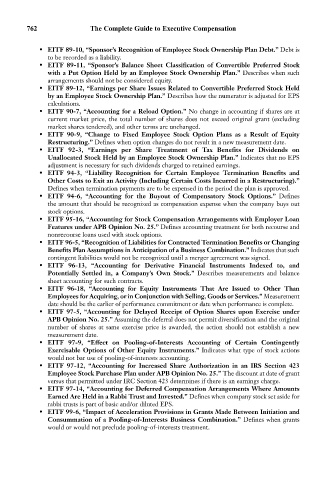Page 777 - Bruce Ellig - The Complete Guide to Executive Compensation (2007)
P. 777
762 The Complete Guide to Executive Compensation
• EITF 89-10, “Sponsor’s Recognition of Employee Stock Ownership Plan Debt.” Debt is
to be recorded as a liability.
• EITF 89-11, “Sponsor’s Balance Sheet Classification of Convertible Preferred Stock
with a Put Option Held by an Employee Stock Ownership Plan.” Describes when such
arrangements should not be considered equity.
• EITF 89-12, “Earnings per Share Issues Related to Convertible Preferred Stock Held
by an Employee Stock Ownership Plan.” Describes how the numerator is adjusted for EPS
calculations.
• EITF 90-7, “Accounting for a Reload Option.” No change in accounting if shares are at
current market price, the total number of shares does not exceed original grant (excluding
market shares tendered), and other terms are unchanged.
• EITF 90-9, “Change to Fixed Employee Stock Option Plans as a Result of Equity
Restructuring.” Defines when option changes do not result in a new measurement date.
• EITF 92-3, “Earnings per Share Treatment of Tax Benefits for Dividends on
Unallocated Stock Held by an Employee Stock Ownership Plan.” Indicates that no EPS
adjustment is necessary for such dividends charged to retained earnings.
• EITF 94-3, “Liability Recognition for Certain Employee Termination Benefits and
Other Costs to Exit an Activity (Including Certain Costs Incurred in a Restructuring).”
Defines when termination payments are to be expensed in the period the plan is approved.
• EITF 94-6, “Accounting for the Buyout of Compensatory Stock Options.” Defines
the amount that should be recognized as compensation expense when the company buys out
stock options.
• EITF 95-16, “Accounting for Stock Compensation Arrangements with Employer Loan
Features under APB Opinion No. 25.” Defines accounting treatment for both recourse and
nonrecourse loans used with stock options.
• EITF 96-5, “Recognition of Liabilities for Contracted Termination Benefits or Changing
Benefits Plan Assumptions in Anticipation of a Business Combination.” Indicates that such
contingent liabilities would not be recognized until a merger agreement was signed.
• EITF 96-13, “Accounting for Derivative Financial Instruments Indexed to, and
Potentially Settled in, a Company’s Own Stock.” Describes measurements and balance
sheet accounting for such contracts.
• EITF 96-18, “Accounting for Equity Instruments That Are Issued to Other Than
Employees for Acquiring, or in Conjunction with Selling, Goods or Services.” Measurement
date should be the earlier of performance commitment or date when performance is complete.
• EITF 97-5, “Accounting for Delayed Receipt of Option Shares upon Exercise under
APB Opinion No. 25.” Assuming the deferral does not permit diversification and the original
number of shares at same exercise price is awarded, the action should not establish a new
measurement date.
• EITF 97-9, “Effect on Pooling-of-Interests Accounting of Certain Contingently
Exercisable Options of Other Equity Instruments.” Indicates what type of stock actions
would not bar use of pooling-of-interests accounting.
• EITF 97-12, “Accounting for Increased Share Authorization in an IRS Section 423
Employee Stock Purchase Plan under APB Opinion No. 25.” The discount at date of grant
versus that permitted under IRC Section 423 determines if there is an earnings charge.
• EITF 97-14, “Accounting for Deferred Compensation Arrangements Where Amounts
Earned Are Held in a Rabbi Trust and Invested.” Defines when company stock set aside for
rabbi trusts is part of basic and/or diluted EPS.
• EITF 99-6, “Impact of Acceleration Provisions in Grants Made Between Initiation and
Consummation of a Pooling-of-Interests Business Combination.” Defines when grants
would or would not preclude pooling-of-interests treatment.

